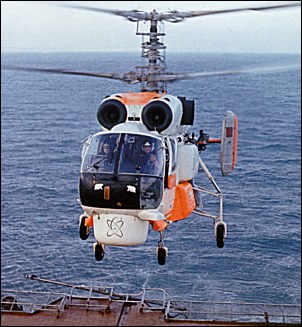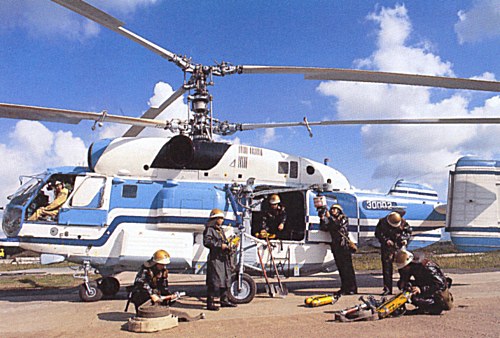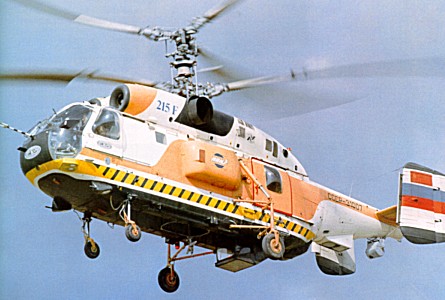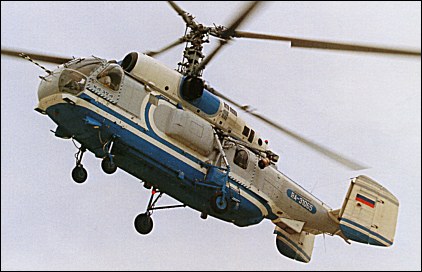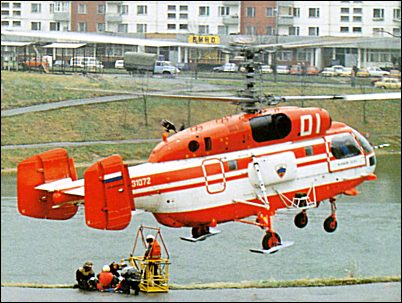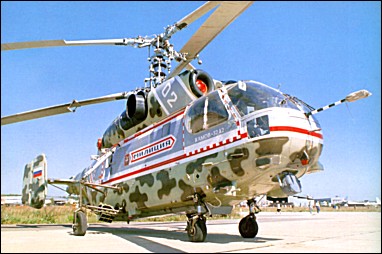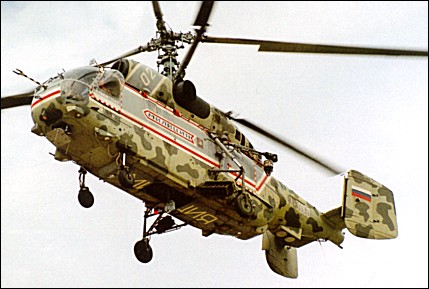Post by Stingray on Jul 11, 2008 19:24:36 GMT -4
Kamov Ka-27 "Helix"
1973
--------------------------------------------------------------------------------
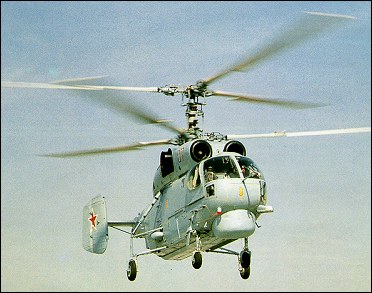
www.aviastar.org/helicopters_eng/ka-27.php
New helicopter broadly based on Ka-25 for Soviet Navy with redesigned broader chord rotor blades, strengthened transmissions and u/c, two tail fins and two 2170shp TV3-117BK turboshafts, increased fuel and 12500kg TOGW. Prot. FF 24 Dec. 1973.
Ka-27PL Helix-A - Ka-27 for anti-submarine missions with extended cockpit with additional windows, enlarged belly weapons bay for four torpedoes and upgraded electronics suite.
Ka-28 Helix-A - Ka-27PL for export customers with 2170shp TV3-117BK turboshafts.
Ka-29 Helix-B - naval assault transport variant of Ka-27 with wider cockpit section, 16-troop cabin, modified chin radar, external weapons pylons with four hardpoints.
Ka-27PS Helix-D - ASR version of Ka-27 without weapons bay, rescue winch, external fuel tanks, searchlight and other rescue equipment.
Ka-31 - Radar post version of Ka-29 with extending belly-mounted radar antenna.
--R.Simpson "Airlife's Helicopter and Rotorcraft", 1998
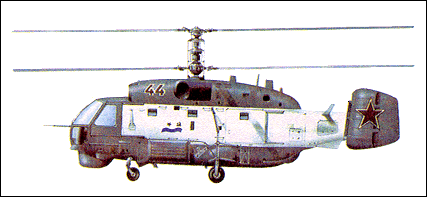
Ka-32
NATO reporting names: Helix-A and D
TYPE: Twin-turbine multipurpose naval helicopter.
PROGRAMME: Design started 1969 to overcome inability of Ka-25 to operate dipping sonar at night and in adverse weather; first flight of prototype 1973; first open reference in US Department of Defense's 1981 Soviet Military Power document, which stated that 'Hormone variant' helicopters could be carried in telescoping hangar on 'Sovremenny' class of guided missile destroyers, for ASW missions; photographs of two on stern platform of Udaloy, first of new class of ASW guided missile destroyers, taken by Western pilots during Baltic exercises, September 1981; at least 16 observed on former 'Kiev' class carrier/cruiser Novorossiysk 1983, as stage in continuous replacement of Ka-25s with Ka-27s. Manufactured by KUMAPE.
CURRENT VERSIONS
Ka-27PL ('Helix-A'): Basic ASW helicopter with three crew; operational since 1982; normally operated in pairs, one tracking hostile submarine, other dropping depth charges.
Ka-27PS ('Helix-D'): Search and rescue and plane guard helicopter; as Ka-27PL, but some operational equipment deleted; external fuel tank each side of cabin, as civil Ka-32; winch beside port cabin door. Air-droppable dinghy packs in ventral stores bay; racks for marker floats.
Ka-28 ('Helix-A'): Export version of Ka-27PL, with 1,618kW TV3-117BK turboshafts and 3,680kg of fuel in 12 tanks. Ka-32 type broad cockpit door and bulged windows.
Ka-29 ('Helix-B'): Described separately.
Ka-32 (civil 'Helix-C'): Described separately; general description applies also to Ka-27 and Ka-28.
DESIGN FEATURES: Basic configuration very like Ka-25, but longer and more capacious fuselage pod, no central tailfin and different undernose radome; similar overall dimensions with rotors folded enable Ka-27 to stow in shipboard hangars and use deck lifts built for Ka-25.
ACCOMMODATION: Crew of three: pilot; tactical coordinator; ASW systems operator.
AVIONICS: Basically as for Ka-32.
Comms: IFF (NATO 'Odd Rods').
Radar: Undernose 360° search radar; directional ESM radomes above rear of engine bay fairing and at tailcone tip.
Flight: Doppler box under tailboom.
Mission: Dipping sonar behind clamshell doors at rear of fuselage pod; sonobuoys stowed internally. MAD.
Self-defence: Optional equipment includes RWR on nose and above tailplane; IR jammer (NATO 'Hot Brick') at rear of engine bay fairing; station-keeping light between ESM radome and jammer; chaff/flare dispensers; colour-coded identification flares.
ARMAMENT: Ventral weapons bay for two torpedoes, four depth charges, other stores.
--Jane's Helicopter Markets and Systems
Technical data for Ka-27
Crew: 2-3, engine: 2 x Klimov TV3-117 turboshaft, rated at 1618kW, rotor diameter: 15.9m, fuselage length: 11.3m, height: 5.4m, take-off weight: 11000kg, max speed: 270km/h, cruising speed: 230km/h, service ceiling: 4300m, range: 800km, endurance: 4.5h
--------------------------------------------------------------------------------
Kamov Ka-29 "Helix-B"
1976
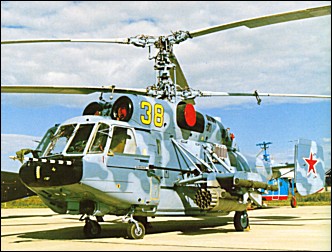
www.aviastar.org/helicopters_eng/ka-29.php
In 1973 in response to a Navy requirement the OKB started the design and construction of a transport/attack derivative of the Ka-27 - the Ka-29 shipboard helicopter. Deputy Chief Designer S.N.Fomin was entrusted with heading the design effort. Leading designer G.M.Danilochkin became his assistant, while B.V.Barshevsky was appointed leading engineer of the test programme. The prototype made its first flight on July 28, 1976 with test pilot Ye.I.Laryushin at the controls. The Ka-29 enhanced the mobility and effectiveness of amphibious landing operations, deploying both on ships and at coastal bases. The helicopter featured an effective navigation, targeting and communication suite. Its armament in the Ka-29TB assault version comprised anti-tank guided missiles, gun pods, unguided rockets, free-fall bombs and submunitions dispensers. The transport version could accomodate 16 fully-armed troops or carry outsize loads weighing up to 4000kg on a sling and was armed with a rapid-firing 7.62-mm machine-gun. The State acceptance trials were completed in May 1979 and production began in 1984.
In the world helicopter design practice there is no direct equivalent to the Ka-29. The ñî-axial helicopter's ease of piloting, coupled with the low vibration level, lessen targeting errors and the initial dispersal of ammunition, which considerably improves firing accuracy. This has been substantiated by comparing the test results of the single-rotor Mi-24 and the ñî-axial Ka-29 equipped with the same models of sights, fixed gun armament and unguided rockets. Weapon accuracy on the Ka-29 proved to be approximately twice as high. In 1987 G.M.Danilochkin was awarded the State Prize for his role in the development of the Ka-29's weapons system.
--G.Kuznetsov "OKB Kamov - 50 years", 1999
Developed for AV-MF, following cancellation of proposed joint-service, tandem-rotor, multirole V-50 and its replacement by what became Ka-50, meeting Army requirement only. Ka-252TB prototype (also known as Izdelie D2B or Izdelie 502) first flew 28 July 1976, possibly with Ka-25 nose or original narrow Ka-27/Ka-32 nose. Production at Kumertau (KAPP) from 1984.
Entered service with Northern and Pacific Fleets 1985; photographed on board assault ship Ivan Rogov in Mediterranean 1987, thought to be Ka-27B and given NATO reporting name 'Helix-B'; identified as Ka-29 combat transport at Frunze (Khodinka) Air Show, Moscow, August 1989; Ka-31 radar picket version completed initial shipboard trials on aircraft carrier Admiral of the Fleet Kuznetsov (then Tbilisi) 1990.
CURRENT VERSIONS:
Ka-29TB ('Helix-B'): Armed derivative for day/night, VFR and IFR, transport and close support of seaborne assault troops; in-the-field conversion from one role to the other. Non-retractable landing gear and 50cm wider armoured flight deck. Reportedly used by Experimental Combat Group in Chechen War in 1996. No recent production known.
Detailed description generally as for Ka-32 except as under.
Ka-31 (formerly Ka-29RLD: radiolokatsyonnogo Dozora: radar picket helicopter): Development began 1980; first flown October 1987; two examples (031 and 032) tested on Admiral of the Fleet Kuznetsov; state testing completed in 1996; limited production launched (for Indian Navy) at Kumertau Aircraft Plant, Bashkiriya, 1999. Indian aircraft have 12-channel Kronshtadt GPS with Abris digital moving map and a 152x203mm AMLCD screen.
Basic airframe of Ka-27 with broader flight deck; E-801 or E-801M (export) Oko (eye) early warning radar system by Radio Engineering Institute, Nizhny Novgorod, includes large rotating radar antenna (area 6.0m2) that stows flat against underfuselage and deploys downward, turning through 90° into vertical plane before starting to rotate at 6 rpm; landing gear retracts upward to prevent interference, nosewheels into long fairings. Once system has been switched on, antenna extended and operation mode selected, data on air targets flying below helicopter’s altitude, and on water surface situation, are acquired, evaluated and transmitted automatically to command centre, requiring only two crew (pilot and navigator, latter monitoring - but not operating - the system) in helicopter. Kronshtadt Kabris GPS navigation and display system. Loiter speed 100 to 120km/h at up to 3,500m; loiter duration 2h 30 min. Maximum surveillance radius 100 to 150km for fighter-size targets, 250km for surface vessels; up to 20 targets tracked simultaneously. Antenna can be retracted manually or explosively jettisoned in the event of a forced landing.
Two large panniers starboard side of cabin, fore and aft of main landing gear on helicopter numbered 032 (forward panniers only on 031); starboard airstair-type cabin door, aft of flight deck, divided horizontally into upward- and downward-opening sections, with box fairing in place of window; hatch window deleted above starboard rear pannier; new TA-8Ka APU positioned ahove rear of engine bay fairing, with slot-type air intake at front of housing, displacing usual ESM and IR jamming pods, gives radar and antenna an independent power supply. Tyre size 620x180 on main wheels, 480x200 on nosewheels. Tailcone extended by fairing tor flight recorder; no armour, guu door, stores pylons or outriggers.
Ka-33: Utility transport. Civilianised version of Ka-29TB shipborne assault transport. Designation revealed tit Moscow Air Show in August 1997; no further details released and no known conversions.
CUSTOMERS: Total of 59 Ka-29s built for Russian Federation Naval Aviation (about 45) and Ukrainian Navy (about 12). Following 1996 evaluation, four Ka-31s ordered in August 1999 by Indian Navy for delivery in 2001 and basing aboard aircraft carriers and 'Krivak' class destroyers; further five ordered. February 2001. Additional 12 maybe required. Fust flight of Indian Ka-31 16 May 2001; by October 2001, first two Indian airframes delivered from KAPP to Kamov at Moscow for avionics installation; flight trials completed of first two Indian aircraft by September 2002; remaining seven scheduled to follow in 2003. In October 2002, Kamov reported a second export customer for Ka-31s in addition to Indian Navy.
COSTS: Indian Navy batch of four priced at Rs4 billion (US$92 million) (2000); second five cost US$108 million (2001).
POWER PLANT: Two Klimov TV3-117VMA turboshafts, each 1,633kW. Engines started by APU. Fuel tanks filled with reticulated polyurethane foam for fire suppression.
ACCOMMODATION: Wider flight deck than Ka-27 for two crew; three flat-plate windscreen glazings instead of two-piece curved transparency; 350kg of armour around cockpit and engines; main cabin port-side door, aft of landing gear, divided honzontally into upward- and downward-opening sections, lower section forming step when open, to facilitate rapid exit of up to 16 assault troops; four stretcher patients, seven seated casualties and medical attendant in ambulance role; internal or slung cargo provisions.
AVIONICS: Comms: Two UHF and HF radios.
Radar: Primary radar in port side of nose.
Flight: INS; Doppler box under tailboom; IFF ('Slap Shot').
Mission: Undernose Shturm-V missile guidance and LLTV pods; ESM 'flower pot' above rear of engine bay (airing.
Self-defence: L-166V IR jammer ('Hot Brick'); chaff/ flare dispensers.
EQUIPMENT: Station-keeping light between ESM and jammer.
ARMAMENT: Four-barrel Gatling-type GShG-7.62 7.62mm machine gun, with 1,800 rounds, flexibly mounted behind down ward-articulated door on starboard side of nose; four pylons on outriggers, for two four-round packs of 9M114 Shturm (AT-6 'Spiral') ASMs and two UV-32-57 57 or B-8V20 80mm rocket pods. Alternative loads include four rocket packs, two pods each containing a 23mm gun and 250 rounds, or twn ZAB 500 incendiary bombs. Internal weapons bay for torpedo or bombs. Provision fur 30mm Type 2A42 gun above port outrigger, with 250-round ammunition feed from cabin.
--Jane's All the World's Aircraft, 2004-2005
Technical data for Ka-29
Crew: 2, engine: 2 x TV3-117VK turboshaft, rated at 1660kW, rotor diameter: 15.90m, length: 11.6m, height: 5.40m, take-off weight: 12600kg, empty weight: 5520kg, max speed: 250km/h, service ceiling: 5000m, range with 2000kg payload: 460km, range with max fuel: 740km
--------------------------------------------------------------------------------
Kamov Ka-31
1987
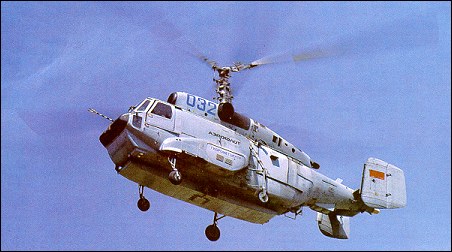
www.aviastar.org/helicopters_eng/ka-31.php
Ka-31 helicopter is intended for long-range detection of air targets of a fixed-wing/helicopter type, including detection at low altitudes, and over-waters ships, their tracking and automatic transmission of their data to the command posts. The helicopter can considerably increase combat mission efficiency of Navy ships, Army aviation and tank detachments by providing them with timely information about the actions of the ships, fixed-wing aircraft and combat helicopters of the enemy.
Ka-31 helicopter is developed on the basis of Ka-27 ship-borne coaxial helicopter. Under the transport cabin floor there is a compartment housing the support-rotating mechanism of a 6-m span antenna. To prevent the interference in the antenna all-round rotation plane the nose landing gear legs are retracted rearward into the cowlings flight-wise and the main legs are retracted upward. In stowed position the antenna is kept against the fuselage bottom. The search and attack equipment of Ka-27 helicopter intended for fighting against sub-marines is dismounted. Instead, a radio-electronic suite is installed for radar target detection, targets identification and transmission of the over-water and air situation data to the ship-based and ground-based command posts. Ka-31 is based on the ships and on the ground.
The core of the on-board avionics suite is powerful solid-state radar. The radio-electronic package automatically controls the helicopter flight over the specified route in any weather and climatic conditions. When the radio-electronic package is on, the antenna is extended and the navigator has elected the operational mode, all further operations are performed automatically without operator interference. The navigator role is simply to control the systems operation and to duplicate target observation on the display screen.
-- www.airshow.ru
Developed for AV-MF, following cancellation of proposed joint-service, tandem-rotor, multirole V-50 and its replacement by what became Ka-50, meeting Army requirement only. Ka-252TB prototype (also known as Izdelie D2B or Izdelie 502) first flew 28 July 1976, possibly with Ka-25 nose or original narrow Ka-27/Ka-32 nose. Production at Kumertau (KAPP) from 1984.
Entered service with Northern and Pacific Fleets 1985; photographed on board assault ship Ivan Rogov in Mediterranean 1987, thought to be Ka-27B and given NATO reporting name 'Helix-B'; identified as Ka-29 combat transport at Frunze (Khodinka) Air Show, Moscow, August 1989; Ka-31 radar picket version completed initial shipboard trials on aircraft carrier Admiral of the Fleet Kuznetsov (then Tbilisi) 1990.
CURRENT VERSIONS:
Ka-29TB ('Helix-B'): Armed derivative for day/night, VFR and IFR, transport and close support of seaborne assault troops; in-the-field conversion from one role to the other. Non-retractable landing gear and 50cm wider armoured flight deck. Reportedly used by Experimental Combat Group in Chechen War in 1996. No recent production known.
Detailed description generally as for Ka-32 except as under.
Ka-31 (formerly Ka-29RLD: radiolokatsyonnogo Dozora: radar picket helicopter): Development began 1980; first flown October 1987; two examples (031 and 032) tested on Admiral of the Fleet Kuznetsov; state testing completed in 1996; limited production launched (for Indian Navy) at Kumertau Aircraft Plant, Bashkiriya, 1999. Indian aircraft have 12-channel Kronshtadt GPS with Abris digital moving map and a 152x203mm AMLCD screen.
Basic airframe of Ka-27 with broader flight deck; E-801 or E-801M (export) Oko (eye) early warning radar system by Radio Engineering Institute, Nizhny Novgorod, includes large rotating radar antenna (area 6.0m2) that stows flat against underfuselage and deploys downward, turning through 90° into vertical plane before starting to rotate at 6 rpm; landing gear retracts upward to prevent interference, nosewheels into long fairings. Once system has been switched on, antenna extended and operation mode selected, data on air targets flying below helicopter’s altitude, and on water surface situation, are acquired, evaluated and transmitted automatically to command centre, requiring only two crew (pilot and navigator, latter monitoring - but not operating - the system) in helicopter. Kronshtadt Kabris GPS navigation and display system. Loiter speed 100 to 120km/h at up to 3,500m; loiter duration 2h 30 min. Maximum surveillance radius 100 to 150km for fighter-size targets, 250km for surface vessels; up to 20 targets tracked simultaneously. Antenna can be retracted manually or explosively jettisoned in the event of a forced landing.
Two large panniers starboard side of cabin, fore and aft of main landing gear on helicopter numbered 032 (forward panniers only on 031); starboard airstair-type cabin door, aft of flight deck, divided horizontally into upward- and downward-opening sections, with box fairing in place of window; hatch window deleted above starboard rear pannier; new TA-8Ka APU positioned ahove rear of engine bay fairing, with slot-type air intake at front of housing, displacing usual ESM and IR jamming pods, gives radar and antenna an independent power supply. Tyre size 620x180 on main wheels, 480x200 on nosewheels. Tailcone extended by fairing tor flight recorder; no armour, guu door, stores pylons or outriggers.
Ka-33: Utility transport. Civilianised version of Ka-29TB shipborne assault transport. Designation revealed tit Moscow Air Show in August 1997; no further details released and no known conversions.
CUSTOMERS: Total of 59 Ka-29s built for Russian Federation Naval Aviation (about 45) and Ukrainian Navy (about 12). Following 1996 evaluation, four Ka-31s ordered in August 1999 by Indian Navy for delivery in 2001 and basing aboard aircraft carriers and 'Krivak' class destroyers; further five ordered. February 2001. Additional 12 maybe required. Fust flight of Indian Ka-31 16 May 2001; by October 2001, first two Indian airframes delivered from KAPP to Kamov at Moscow for avionics installation; flight trials completed of first two Indian aircraft by September 2002; remaining seven scheduled to follow in 2003. In October 2002, Kamov reported a second export customer for Ka-31s in addition to Indian Navy.
COSTS: Indian Navy batch of four priced at Rs4 billion (US$92 million) (2000); second five cost US$108 million (2001).
POWER PLANT: Two Klimov TV3-117VMA turboshafts, each 1,633kW. Engines started by APU. Fuel tanks filled with reticulated polyurethane foam for fire suppression.
ACCOMMODATION: Wider flight deck than Ka-27 for two crew; three flat-plate windscreen glazings instead of two-piece curved transparency; 350kg of armour around cockpit and engines; main cabin port-side door, aft of landing gear, divided honzontally into upward- and downward-opening sections, lower section forming step when open, to facilitate rapid exit of up to 16 assault troops; four stretcher patients, seven seated casualties and medical attendant in ambulance role; internal or slung cargo provisions.
AVIONICS: Comms: Two UHF and HF radios.
Radar: Primary radar in port side of nose.
Flight: INS; Doppler box under tailboom; IFF ('Slap Shot').
Mission: Undernose Shturm-V missile guidance and LLTV pods; ESM 'flower pot' above rear of engine bay (airing.
Self-defence: L-166V IR jammer ('Hot Brick'); chaff/ flare dispensers.
EQUIPMENT: Station-keeping light between ESM and jammer.
ARMAMENT: Four-barrel Gatling-type GShG-7.62 7.62mm machine gun, with 1,800 rounds, flexibly mounted behind down ward-articulated door on starboard side of nose; four pylons on outriggers, for two four-round packs of 9M114 Shturm (AT-6 'Spiral') ASMs and two UV-32-57 57 or B-8V20 80mm rocket pods. Alternative loads include four rocket packs, two pods each containing a 23mm gun and 250 rounds, or twn ZAB 500 incendiary bombs. Internal weapons bay for torpedo or bombs. Provision fur 30mm Type 2A42 gun above port outrigger, with 250-round ammunition feed from cabin.
--Jane's All the World's Aircraft, 2004-2005
Technical data for Ka-31
Crew: 2-3, rotor diameter: 15.90m, fuselage length: 11.30m, height: 5.60m, take-off weight: 12500kg, max speed: 255km/h, cruising speed: 220km/h, hovering ceiling: 3700m, ceiling when on a patrol: 3500m, range with max fuel: 680km, endurance:1.5-2h
Continued...
1973
--------------------------------------------------------------------------------

www.aviastar.org/helicopters_eng/ka-27.php
New helicopter broadly based on Ka-25 for Soviet Navy with redesigned broader chord rotor blades, strengthened transmissions and u/c, two tail fins and two 2170shp TV3-117BK turboshafts, increased fuel and 12500kg TOGW. Prot. FF 24 Dec. 1973.
Ka-27PL Helix-A - Ka-27 for anti-submarine missions with extended cockpit with additional windows, enlarged belly weapons bay for four torpedoes and upgraded electronics suite.
Ka-28 Helix-A - Ka-27PL for export customers with 2170shp TV3-117BK turboshafts.
Ka-29 Helix-B - naval assault transport variant of Ka-27 with wider cockpit section, 16-troop cabin, modified chin radar, external weapons pylons with four hardpoints.
Ka-27PS Helix-D - ASR version of Ka-27 without weapons bay, rescue winch, external fuel tanks, searchlight and other rescue equipment.
Ka-31 - Radar post version of Ka-29 with extending belly-mounted radar antenna.
--R.Simpson "Airlife's Helicopter and Rotorcraft", 1998

Ka-32
NATO reporting names: Helix-A and D
TYPE: Twin-turbine multipurpose naval helicopter.
PROGRAMME: Design started 1969 to overcome inability of Ka-25 to operate dipping sonar at night and in adverse weather; first flight of prototype 1973; first open reference in US Department of Defense's 1981 Soviet Military Power document, which stated that 'Hormone variant' helicopters could be carried in telescoping hangar on 'Sovremenny' class of guided missile destroyers, for ASW missions; photographs of two on stern platform of Udaloy, first of new class of ASW guided missile destroyers, taken by Western pilots during Baltic exercises, September 1981; at least 16 observed on former 'Kiev' class carrier/cruiser Novorossiysk 1983, as stage in continuous replacement of Ka-25s with Ka-27s. Manufactured by KUMAPE.
CURRENT VERSIONS
Ka-27PL ('Helix-A'): Basic ASW helicopter with three crew; operational since 1982; normally operated in pairs, one tracking hostile submarine, other dropping depth charges.
Ka-27PS ('Helix-D'): Search and rescue and plane guard helicopter; as Ka-27PL, but some operational equipment deleted; external fuel tank each side of cabin, as civil Ka-32; winch beside port cabin door. Air-droppable dinghy packs in ventral stores bay; racks for marker floats.
Ka-28 ('Helix-A'): Export version of Ka-27PL, with 1,618kW TV3-117BK turboshafts and 3,680kg of fuel in 12 tanks. Ka-32 type broad cockpit door and bulged windows.
Ka-29 ('Helix-B'): Described separately.
Ka-32 (civil 'Helix-C'): Described separately; general description applies also to Ka-27 and Ka-28.
DESIGN FEATURES: Basic configuration very like Ka-25, but longer and more capacious fuselage pod, no central tailfin and different undernose radome; similar overall dimensions with rotors folded enable Ka-27 to stow in shipboard hangars and use deck lifts built for Ka-25.
ACCOMMODATION: Crew of three: pilot; tactical coordinator; ASW systems operator.
AVIONICS: Basically as for Ka-32.
Comms: IFF (NATO 'Odd Rods').
Radar: Undernose 360° search radar; directional ESM radomes above rear of engine bay fairing and at tailcone tip.
Flight: Doppler box under tailboom.
Mission: Dipping sonar behind clamshell doors at rear of fuselage pod; sonobuoys stowed internally. MAD.
Self-defence: Optional equipment includes RWR on nose and above tailplane; IR jammer (NATO 'Hot Brick') at rear of engine bay fairing; station-keeping light between ESM radome and jammer; chaff/flare dispensers; colour-coded identification flares.
ARMAMENT: Ventral weapons bay for two torpedoes, four depth charges, other stores.
--Jane's Helicopter Markets and Systems
Technical data for Ka-27
Crew: 2-3, engine: 2 x Klimov TV3-117 turboshaft, rated at 1618kW, rotor diameter: 15.9m, fuselage length: 11.3m, height: 5.4m, take-off weight: 11000kg, max speed: 270km/h, cruising speed: 230km/h, service ceiling: 4300m, range: 800km, endurance: 4.5h
--------------------------------------------------------------------------------
Kamov Ka-29 "Helix-B"
1976

www.aviastar.org/helicopters_eng/ka-29.php
In 1973 in response to a Navy requirement the OKB started the design and construction of a transport/attack derivative of the Ka-27 - the Ka-29 shipboard helicopter. Deputy Chief Designer S.N.Fomin was entrusted with heading the design effort. Leading designer G.M.Danilochkin became his assistant, while B.V.Barshevsky was appointed leading engineer of the test programme. The prototype made its first flight on July 28, 1976 with test pilot Ye.I.Laryushin at the controls. The Ka-29 enhanced the mobility and effectiveness of amphibious landing operations, deploying both on ships and at coastal bases. The helicopter featured an effective navigation, targeting and communication suite. Its armament in the Ka-29TB assault version comprised anti-tank guided missiles, gun pods, unguided rockets, free-fall bombs and submunitions dispensers. The transport version could accomodate 16 fully-armed troops or carry outsize loads weighing up to 4000kg on a sling and was armed with a rapid-firing 7.62-mm machine-gun. The State acceptance trials were completed in May 1979 and production began in 1984.
In the world helicopter design practice there is no direct equivalent to the Ka-29. The ñî-axial helicopter's ease of piloting, coupled with the low vibration level, lessen targeting errors and the initial dispersal of ammunition, which considerably improves firing accuracy. This has been substantiated by comparing the test results of the single-rotor Mi-24 and the ñî-axial Ka-29 equipped with the same models of sights, fixed gun armament and unguided rockets. Weapon accuracy on the Ka-29 proved to be approximately twice as high. In 1987 G.M.Danilochkin was awarded the State Prize for his role in the development of the Ka-29's weapons system.
--G.Kuznetsov "OKB Kamov - 50 years", 1999
Developed for AV-MF, following cancellation of proposed joint-service, tandem-rotor, multirole V-50 and its replacement by what became Ka-50, meeting Army requirement only. Ka-252TB prototype (also known as Izdelie D2B or Izdelie 502) first flew 28 July 1976, possibly with Ka-25 nose or original narrow Ka-27/Ka-32 nose. Production at Kumertau (KAPP) from 1984.
Entered service with Northern and Pacific Fleets 1985; photographed on board assault ship Ivan Rogov in Mediterranean 1987, thought to be Ka-27B and given NATO reporting name 'Helix-B'; identified as Ka-29 combat transport at Frunze (Khodinka) Air Show, Moscow, August 1989; Ka-31 radar picket version completed initial shipboard trials on aircraft carrier Admiral of the Fleet Kuznetsov (then Tbilisi) 1990.
CURRENT VERSIONS:
Ka-29TB ('Helix-B'): Armed derivative for day/night, VFR and IFR, transport and close support of seaborne assault troops; in-the-field conversion from one role to the other. Non-retractable landing gear and 50cm wider armoured flight deck. Reportedly used by Experimental Combat Group in Chechen War in 1996. No recent production known.
Detailed description generally as for Ka-32 except as under.
Ka-31 (formerly Ka-29RLD: radiolokatsyonnogo Dozora: radar picket helicopter): Development began 1980; first flown October 1987; two examples (031 and 032) tested on Admiral of the Fleet Kuznetsov; state testing completed in 1996; limited production launched (for Indian Navy) at Kumertau Aircraft Plant, Bashkiriya, 1999. Indian aircraft have 12-channel Kronshtadt GPS with Abris digital moving map and a 152x203mm AMLCD screen.
Basic airframe of Ka-27 with broader flight deck; E-801 or E-801M (export) Oko (eye) early warning radar system by Radio Engineering Institute, Nizhny Novgorod, includes large rotating radar antenna (area 6.0m2) that stows flat against underfuselage and deploys downward, turning through 90° into vertical plane before starting to rotate at 6 rpm; landing gear retracts upward to prevent interference, nosewheels into long fairings. Once system has been switched on, antenna extended and operation mode selected, data on air targets flying below helicopter’s altitude, and on water surface situation, are acquired, evaluated and transmitted automatically to command centre, requiring only two crew (pilot and navigator, latter monitoring - but not operating - the system) in helicopter. Kronshtadt Kabris GPS navigation and display system. Loiter speed 100 to 120km/h at up to 3,500m; loiter duration 2h 30 min. Maximum surveillance radius 100 to 150km for fighter-size targets, 250km for surface vessels; up to 20 targets tracked simultaneously. Antenna can be retracted manually or explosively jettisoned in the event of a forced landing.
Two large panniers starboard side of cabin, fore and aft of main landing gear on helicopter numbered 032 (forward panniers only on 031); starboard airstair-type cabin door, aft of flight deck, divided horizontally into upward- and downward-opening sections, with box fairing in place of window; hatch window deleted above starboard rear pannier; new TA-8Ka APU positioned ahove rear of engine bay fairing, with slot-type air intake at front of housing, displacing usual ESM and IR jamming pods, gives radar and antenna an independent power supply. Tyre size 620x180 on main wheels, 480x200 on nosewheels. Tailcone extended by fairing tor flight recorder; no armour, guu door, stores pylons or outriggers.
Ka-33: Utility transport. Civilianised version of Ka-29TB shipborne assault transport. Designation revealed tit Moscow Air Show in August 1997; no further details released and no known conversions.
CUSTOMERS: Total of 59 Ka-29s built for Russian Federation Naval Aviation (about 45) and Ukrainian Navy (about 12). Following 1996 evaluation, four Ka-31s ordered in August 1999 by Indian Navy for delivery in 2001 and basing aboard aircraft carriers and 'Krivak' class destroyers; further five ordered. February 2001. Additional 12 maybe required. Fust flight of Indian Ka-31 16 May 2001; by October 2001, first two Indian airframes delivered from KAPP to Kamov at Moscow for avionics installation; flight trials completed of first two Indian aircraft by September 2002; remaining seven scheduled to follow in 2003. In October 2002, Kamov reported a second export customer for Ka-31s in addition to Indian Navy.
COSTS: Indian Navy batch of four priced at Rs4 billion (US$92 million) (2000); second five cost US$108 million (2001).
POWER PLANT: Two Klimov TV3-117VMA turboshafts, each 1,633kW. Engines started by APU. Fuel tanks filled with reticulated polyurethane foam for fire suppression.
ACCOMMODATION: Wider flight deck than Ka-27 for two crew; three flat-plate windscreen glazings instead of two-piece curved transparency; 350kg of armour around cockpit and engines; main cabin port-side door, aft of landing gear, divided honzontally into upward- and downward-opening sections, lower section forming step when open, to facilitate rapid exit of up to 16 assault troops; four stretcher patients, seven seated casualties and medical attendant in ambulance role; internal or slung cargo provisions.
AVIONICS: Comms: Two UHF and HF radios.
Radar: Primary radar in port side of nose.
Flight: INS; Doppler box under tailboom; IFF ('Slap Shot').
Mission: Undernose Shturm-V missile guidance and LLTV pods; ESM 'flower pot' above rear of engine bay (airing.
Self-defence: L-166V IR jammer ('Hot Brick'); chaff/ flare dispensers.
EQUIPMENT: Station-keeping light between ESM and jammer.
ARMAMENT: Four-barrel Gatling-type GShG-7.62 7.62mm machine gun, with 1,800 rounds, flexibly mounted behind down ward-articulated door on starboard side of nose; four pylons on outriggers, for two four-round packs of 9M114 Shturm (AT-6 'Spiral') ASMs and two UV-32-57 57 or B-8V20 80mm rocket pods. Alternative loads include four rocket packs, two pods each containing a 23mm gun and 250 rounds, or twn ZAB 500 incendiary bombs. Internal weapons bay for torpedo or bombs. Provision fur 30mm Type 2A42 gun above port outrigger, with 250-round ammunition feed from cabin.
--Jane's All the World's Aircraft, 2004-2005
Technical data for Ka-29
Crew: 2, engine: 2 x TV3-117VK turboshaft, rated at 1660kW, rotor diameter: 15.90m, length: 11.6m, height: 5.40m, take-off weight: 12600kg, empty weight: 5520kg, max speed: 250km/h, service ceiling: 5000m, range with 2000kg payload: 460km, range with max fuel: 740km
--------------------------------------------------------------------------------
Kamov Ka-31
1987

www.aviastar.org/helicopters_eng/ka-31.php
Ka-31 helicopter is intended for long-range detection of air targets of a fixed-wing/helicopter type, including detection at low altitudes, and over-waters ships, their tracking and automatic transmission of their data to the command posts. The helicopter can considerably increase combat mission efficiency of Navy ships, Army aviation and tank detachments by providing them with timely information about the actions of the ships, fixed-wing aircraft and combat helicopters of the enemy.
Ka-31 helicopter is developed on the basis of Ka-27 ship-borne coaxial helicopter. Under the transport cabin floor there is a compartment housing the support-rotating mechanism of a 6-m span antenna. To prevent the interference in the antenna all-round rotation plane the nose landing gear legs are retracted rearward into the cowlings flight-wise and the main legs are retracted upward. In stowed position the antenna is kept against the fuselage bottom. The search and attack equipment of Ka-27 helicopter intended for fighting against sub-marines is dismounted. Instead, a radio-electronic suite is installed for radar target detection, targets identification and transmission of the over-water and air situation data to the ship-based and ground-based command posts. Ka-31 is based on the ships and on the ground.
The core of the on-board avionics suite is powerful solid-state radar. The radio-electronic package automatically controls the helicopter flight over the specified route in any weather and climatic conditions. When the radio-electronic package is on, the antenna is extended and the navigator has elected the operational mode, all further operations are performed automatically without operator interference. The navigator role is simply to control the systems operation and to duplicate target observation on the display screen.
-- www.airshow.ru
Developed for AV-MF, following cancellation of proposed joint-service, tandem-rotor, multirole V-50 and its replacement by what became Ka-50, meeting Army requirement only. Ka-252TB prototype (also known as Izdelie D2B or Izdelie 502) first flew 28 July 1976, possibly with Ka-25 nose or original narrow Ka-27/Ka-32 nose. Production at Kumertau (KAPP) from 1984.
Entered service with Northern and Pacific Fleets 1985; photographed on board assault ship Ivan Rogov in Mediterranean 1987, thought to be Ka-27B and given NATO reporting name 'Helix-B'; identified as Ka-29 combat transport at Frunze (Khodinka) Air Show, Moscow, August 1989; Ka-31 radar picket version completed initial shipboard trials on aircraft carrier Admiral of the Fleet Kuznetsov (then Tbilisi) 1990.
CURRENT VERSIONS:
Ka-29TB ('Helix-B'): Armed derivative for day/night, VFR and IFR, transport and close support of seaborne assault troops; in-the-field conversion from one role to the other. Non-retractable landing gear and 50cm wider armoured flight deck. Reportedly used by Experimental Combat Group in Chechen War in 1996. No recent production known.
Detailed description generally as for Ka-32 except as under.
Ka-31 (formerly Ka-29RLD: radiolokatsyonnogo Dozora: radar picket helicopter): Development began 1980; first flown October 1987; two examples (031 and 032) tested on Admiral of the Fleet Kuznetsov; state testing completed in 1996; limited production launched (for Indian Navy) at Kumertau Aircraft Plant, Bashkiriya, 1999. Indian aircraft have 12-channel Kronshtadt GPS with Abris digital moving map and a 152x203mm AMLCD screen.
Basic airframe of Ka-27 with broader flight deck; E-801 or E-801M (export) Oko (eye) early warning radar system by Radio Engineering Institute, Nizhny Novgorod, includes large rotating radar antenna (area 6.0m2) that stows flat against underfuselage and deploys downward, turning through 90° into vertical plane before starting to rotate at 6 rpm; landing gear retracts upward to prevent interference, nosewheels into long fairings. Once system has been switched on, antenna extended and operation mode selected, data on air targets flying below helicopter’s altitude, and on water surface situation, are acquired, evaluated and transmitted automatically to command centre, requiring only two crew (pilot and navigator, latter monitoring - but not operating - the system) in helicopter. Kronshtadt Kabris GPS navigation and display system. Loiter speed 100 to 120km/h at up to 3,500m; loiter duration 2h 30 min. Maximum surveillance radius 100 to 150km for fighter-size targets, 250km for surface vessels; up to 20 targets tracked simultaneously. Antenna can be retracted manually or explosively jettisoned in the event of a forced landing.
Two large panniers starboard side of cabin, fore and aft of main landing gear on helicopter numbered 032 (forward panniers only on 031); starboard airstair-type cabin door, aft of flight deck, divided horizontally into upward- and downward-opening sections, with box fairing in place of window; hatch window deleted above starboard rear pannier; new TA-8Ka APU positioned ahove rear of engine bay fairing, with slot-type air intake at front of housing, displacing usual ESM and IR jamming pods, gives radar and antenna an independent power supply. Tyre size 620x180 on main wheels, 480x200 on nosewheels. Tailcone extended by fairing tor flight recorder; no armour, guu door, stores pylons or outriggers.
Ka-33: Utility transport. Civilianised version of Ka-29TB shipborne assault transport. Designation revealed tit Moscow Air Show in August 1997; no further details released and no known conversions.
CUSTOMERS: Total of 59 Ka-29s built for Russian Federation Naval Aviation (about 45) and Ukrainian Navy (about 12). Following 1996 evaluation, four Ka-31s ordered in August 1999 by Indian Navy for delivery in 2001 and basing aboard aircraft carriers and 'Krivak' class destroyers; further five ordered. February 2001. Additional 12 maybe required. Fust flight of Indian Ka-31 16 May 2001; by October 2001, first two Indian airframes delivered from KAPP to Kamov at Moscow for avionics installation; flight trials completed of first two Indian aircraft by September 2002; remaining seven scheduled to follow in 2003. In October 2002, Kamov reported a second export customer for Ka-31s in addition to Indian Navy.
COSTS: Indian Navy batch of four priced at Rs4 billion (US$92 million) (2000); second five cost US$108 million (2001).
POWER PLANT: Two Klimov TV3-117VMA turboshafts, each 1,633kW. Engines started by APU. Fuel tanks filled with reticulated polyurethane foam for fire suppression.
ACCOMMODATION: Wider flight deck than Ka-27 for two crew; three flat-plate windscreen glazings instead of two-piece curved transparency; 350kg of armour around cockpit and engines; main cabin port-side door, aft of landing gear, divided honzontally into upward- and downward-opening sections, lower section forming step when open, to facilitate rapid exit of up to 16 assault troops; four stretcher patients, seven seated casualties and medical attendant in ambulance role; internal or slung cargo provisions.
AVIONICS: Comms: Two UHF and HF radios.
Radar: Primary radar in port side of nose.
Flight: INS; Doppler box under tailboom; IFF ('Slap Shot').
Mission: Undernose Shturm-V missile guidance and LLTV pods; ESM 'flower pot' above rear of engine bay (airing.
Self-defence: L-166V IR jammer ('Hot Brick'); chaff/ flare dispensers.
EQUIPMENT: Station-keeping light between ESM and jammer.
ARMAMENT: Four-barrel Gatling-type GShG-7.62 7.62mm machine gun, with 1,800 rounds, flexibly mounted behind down ward-articulated door on starboard side of nose; four pylons on outriggers, for two four-round packs of 9M114 Shturm (AT-6 'Spiral') ASMs and two UV-32-57 57 or B-8V20 80mm rocket pods. Alternative loads include four rocket packs, two pods each containing a 23mm gun and 250 rounds, or twn ZAB 500 incendiary bombs. Internal weapons bay for torpedo or bombs. Provision fur 30mm Type 2A42 gun above port outrigger, with 250-round ammunition feed from cabin.
--Jane's All the World's Aircraft, 2004-2005
Technical data for Ka-31
Crew: 2-3, rotor diameter: 15.90m, fuselage length: 11.30m, height: 5.60m, take-off weight: 12500kg, max speed: 255km/h, cruising speed: 220km/h, hovering ceiling: 3700m, ceiling when on a patrol: 3500m, range with max fuel: 680km, endurance:1.5-2h
Continued...






